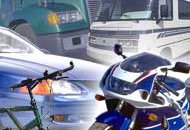 If you are thinking about getting into cycling, whether for exercise, fun or as an alternative method of getting to work, there are some things you should know.
If you are thinking about getting into cycling, whether for exercise, fun or as an alternative method of getting to work, there are some things you should know.
- If you are under 18, wearing a helmet is mandatory in California. Even if you are over 18, you should still wear a helmet. It is one of the most important pieces of safety gear you’ll own. But it’s not enough to just wear one – you must wear it right. The helmet should be snug and level on your head. The chin strap should be snug under your chin and the front of the helmet should not be more than one inch above your eyebrows.
- All cyclists must use hand signals to communicate their intent to stop, turn or change lanes. In case you are unfamiliar with these universal signals:
- Left turn – extend your left arm out sideways with all fingers extended, or use your index finger to point left
- Right turn – extend your left arm out sideways bent at a 90-degree angle at the elbow joint, hand pointing upward and palm facing forward. You could also extend your right arm straight out and extend your fingers or point to the right
- Stopping or slowing – extend your left or right arm sideways and bend it at a 90-degree angle, facing down, with your palm facing backwards. Alternatively, form a fist with left hand and hold it behind your back
- California law (and common sense) demands lights and reflectors when you ride at night. Your bike requires a white headlamp with a range of 300 feet, and a red reflector that is visible from at least 500 feet away. You also need white or yellow reflectors on pedals, each side forward of the bicycle center and a white or red reflector on each side behind the bike center – basically, you need to be able to be seen at night. It is also advised to wear bright, reflective clothing.
- You must follow the rules of the road.


























 1620 5th Avenue
1620 5th Avenue 1620 5th Avenue
1620 5th Avenue